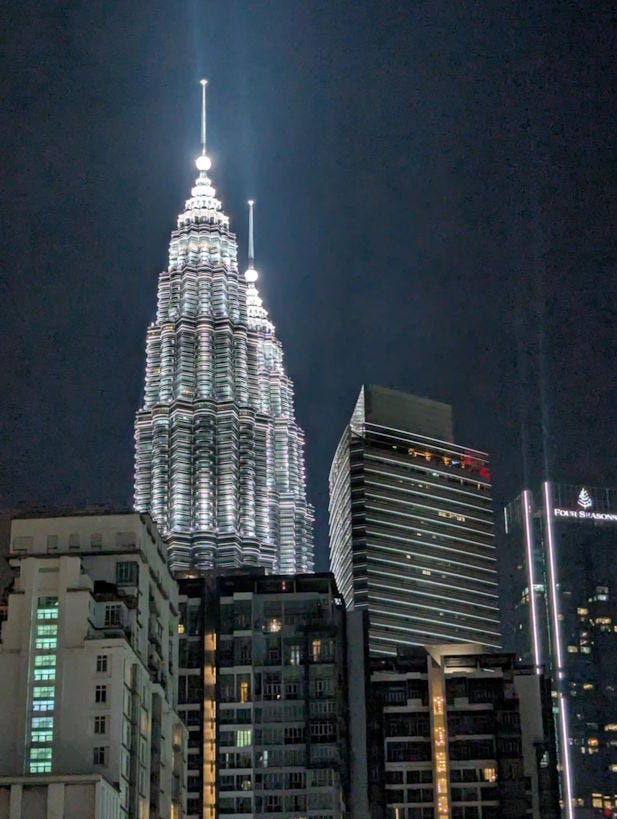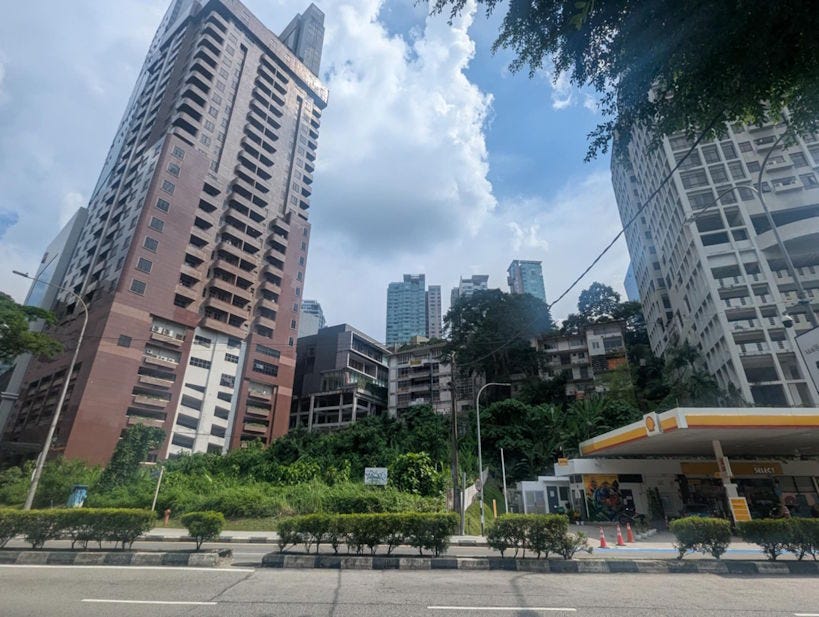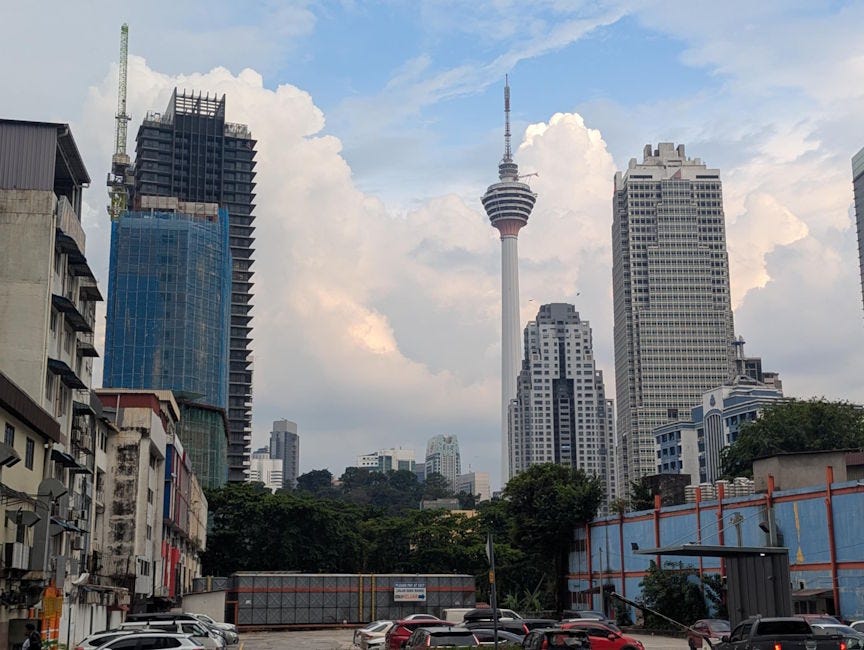|
After I spoke at the Network State conference in Singapore this week, I took a three-day side trip to Malaysia. As I always say, there’s a very limited amount you can learn about a country by going there and wandering around the capital city for a couple of days, so I’m not going to pretend that this little vacation gave me deep insight into the country. But people do seem to like these little travelogue posts — here are the ones I did for the Netherlands, Taiwan, Ireland, and Singapore — so I figured I’d do one for Malaysia too.
Very few people outside Malaysia seem to care about the country, or even know much about it, and that’s not surprising. It’s not very big — just 35 million people or thereabouts. It’s at the lower end of the income scale for a developed country — about $43,000 in per capita GDP (PPP), similar to Turkey or Greece. It doesn’t have many cultural exports — you won’t see M-pop bands, or M-dramas, or Malaysian movies winning international awards. Malaysian food isn’t even very distinct; it’s a blend of dishes from nearby countries, maybe with a bit more spice and oil. When my Singaporean friends tell me they go to Malaysia “to eat”, what they primarily mean is that they go to eat various types of southern Chinese cuisine but with a lot more spice and oil than Singaporean restaurants typically serve.
I think this gets at a big reason Malaysia doesn’t occupy much mindshare, which is also a reason it’s an interesting country — it’s basically an international crossroads. Geographically, it’s located close to China, India, Indonesia, and Thailand, and because of its majority Muslim religion it has connections to the Arab world as well. There was sort of a small Malaysian Empire around 1400 to 1000 years ago, and an even smaller one around 500 years ago, but Malaysia has spent most of its history ruled by outside powers (most recently the British) who brought in outside cultures and people to mix in the area.
More than perhaps any other country, Malaysia is — as the famous tourism slogan says — truly Asia.
A little over half of the people in Malaysia are part of an ethnic group called “Malays” (hence the name of the country). If you think of a “race” as a bunch of people who all have similar appearances, then “Malay” isn’t really a race. It’s more like five races in a trenchcoat — Javanese, Thai, Bornean, Indian, Chinese, and some other smaller ones mixed in. You immediately notice this walking around Kuala Lumpur — other than hijabs for women and thin moustaches for men, there isn’t much to indicate that you’re looking at one singular “people”. Nor is “Malay” even really an ethnicity, if an “ethnicity” is a bunch of people who speak the same language; the “Malay” language is broken up into a bunch of different local dialects.
In the years since independence, the Malaysian government has worked hard to create unity from this jumble of diversity. Religion has been used as a force to unify the Malay people — in order to be classified as a Malay in Malaysia, you have to be Muslim, and the government tries to enforce a single nationwide form of the religion.
The Malaysian government has also tried to create uniformity through race. They created a new racial concept called “Bumiputera” (or “Bumi” for short), meaning “sons of the soil”, which includes the Malays and some minorities. If you ever doubted that race is a social construct, check out the Bumiputeras. Essentially, it’s a political coalition — the Bumiputeras stand in contrast to the Chinese, who make up almost a quarter of the country’s population.
The Malaysian Chinese are an economic elite, owning many of the country’s businesses, and the Bumiputeras were basically created as a coalition to make sure everyone else got a cut of the money and power. Racial discrimination is enshrined in Malaysian law, with part of the Malaysian constitution ensuring that Bumiputeras get government jobs and other benefits, and a long-running economic policy ensuring that Bumiputeras own a significant amount of the country’s stocks and get various other economic support. Malaysians — or at least, Malaysian Bumiputeras — generally prefer to think of these policies not as racial discrimination, but as “affirmative action”.¹
So anyway, Malaysia is an incredibly diverse place that’s in the process of trying to force itself to think of itself as homogeneous. It’s an interesting case study for Americans who believe the now-fashionable right-wing dogma that diversity breeds conflict. On one hand, Malaysia has a history of conflict between Malays and ethnic Chinese — often including race riots — which is why Singapore separated from Malaysia in 1965. But as of today, Malaysia has a wildly diverse cobbled-together “majority” and a very substantial Chinese minority, and yet it’s one of the safest countries on the planet. By the most recent measurement, Malaysia has a murder rate of 0.74 per 100,000 — lower than Sweden or Denmark, and barely higher than China. The numbers are probably a little bit understated, but not by much.
I don’t want to over-interpret my impressions from just walking around, but you can sort of feel this safety on the street. No one seems nervous, everyone seems friendly and relaxed. There are some security guards, but they’re not armed, and there’s not much police presence at all. Nor do Malaysians seem to feel a need to sequester themselves in far-flung suburbs or compounds for physical safety — driving outside of the city center, you see endless forests of apartment towers, similar to what you see in Taiwan, Hong Kong, or Singapore.
Malaysia is a developed country, but Kuala Lumpur feels like it’s still developing. The city is an absolute jumble of different urban layouts, land uses, and architectural styles.
Massive arterial roads exist right alongside little decaying side streets and glittering, immaculate shopping areas. There are gas stations next to apartment towers, overgrown lots next to scenic tourist sites. Everyone jaywalks, even across major roads. Cars are everywhere, but there are a ton of people just standing around on the street.
It’s hot on the street. Malaysia is nearly smack dab on the equator, and it’s pretty much the same weather year-round — hot and muggy. As in Singapore, air conditioning is life here; without it, it’s hard to think straight, and as Lee Kuan Yew pointed out, you can only get work done at dawn or dusk. It’s not pleasant to think about the half of the Malaysian population who still have to go without it, trapped in sweltering dark rooms in front of buzzing dusty fans. In Malaysia, economic success means owning an air conditioner.


